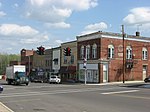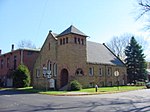The Ohio Country, (Ohio Territory, Ohio Valley) was a name used before 1787 for a region of North America west of the Appalachian Mountains, north of the upper Ohio and Allegheny rivers, and extending to Lake Erie. The area encompassed present-day northwestern West Virginia, Western Pennsylvania, most of Ohio, and a wedge of southeastern Indiana.
Control of the territory and the region's fur trade was disputed in the 17th century by the Iroquois, Huron, Algonquin, other Native American tribes, and France. New France claimed this area as part of the administrative district of La Louisiane. France and Britain fought the French and Indian War over this area in the mid-18th century as the North American front of their Seven Years' War (1753–1763). Following the British victory, France ceded its territory east of the Mississippi River to them in the 1763 Treaty of Paris.
During the following decades, several minor frontier wars, including Pontiac's Rebellion and Lord Dunmore's War, were fought in the territory. In 1783, the Ohio Country became unorganized U.S. territory under the Treaty of Paris that officially ended the American Revolutionary War and became one of the first frontier regions of the United States. Several U.S. states had conflicting claims to portions of it, based on historical royal and colonial charters. The states' claims were largely extinguished after negotiations with the federal government by 1787, and it became part of the larger, organized U.S. Northwest Territory. Most of the former areas north and west of the Ohio River were organized as the state of Ohio, admitted to the Union in 1803.








